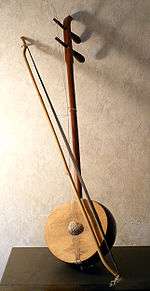Gehu
| Classification | |
|---|---|
| Related instruments | |
The gehu (革胡; pinyin: géhú) is a Chinese instrument developed in the 20th century by the Chinese musician Yang Yusen (杨雨森, 1926-1980). It is a fusion of the Chinese huqin family and the cello. Its four strings are also tuned (from low to high) C-G-D-A, exactly like the cello's. Unlike most other musical instruments in the huqin family, the bridge does not contact the snakeskin, which faces to the side
There is also a contrabass gehu that functions as a Chinese double bass, known as the diyingehu, digehu, or beigehu (倍革胡).
By the late 20th century the gehu had become a rare instrument, even within China, as the tendency for the snakeskin to lose its tightness increases with humidity. Today, it is used mostly in Hong Kong and Taiwan, although even there, the cello is beginning to become a popular replacement for it. In addition, there are also other Chinese instruments that are able to take on the role bowed bass range instrument, such as the laruan (which uses the structure and acoustics of the ruan), the lapa (also known as paqin, using the structure of the pipa), and the bass matouqin.
See also
External links
- Gehu page from Paul and Bernice Noll Website
- Gehu page (Chinese)
- "Chinese Version of the Cello and Double Bass, by Brandon Voo
Video
- Video of a piece for gehu and Chinese traditional instrument orchestra, entitled 草原风情 ("Grasslands Character and Style"), performed by Dong Jinchi (董金池), from CCTV
- Rossini Duet for Cello and Double Bass, played by a gehu and diyingehu.
